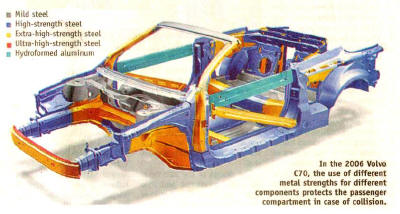|
Engineering
safety into a convertible
BY NEAL WHITE, MOTOR NEWS
MEDIA, (Orange County Register March 16, 2006)
Convertibles pose unique challenges to engineers due to the fact the vehicle
does not have a roof. In
sedans and coupes, the structure includes three main supports: the A-pillar,
which to used to hold the
front windscreen and the front part of the door the B-pillar, which serves
as the brace at the end of the
front door, and in the case of sedans, the beginning of the second door and
the C-pillar, which
supports the rear windscreen at the rear of the car.
In addition to providing enhanced structural Integrity for the vehicle, the
three pillars also support the
roof in the event of a rollover. When engineering the 2006 Volvo C70
four-passenger convertible,
safety had to be part of the design.
“From the outset, we wanted to build one of the safest convertibles on the
market," said James Hope,
product communications manager “We took our Volvo DNA and evolved it."
To achieve that goal, the lack of a fixed roof was compensated for with
reinforcements and sophisticated
technology. In a side collision, where the B-pillar is exposed to
considerable force, engineers had to build
protection in a different way. In the case of the 2006 C70, the forces were
channeled forwards, backwards
and downwards into the body structure, where an integrated system of members
and reinforcements
interact to help keep the passenger compartment as intact as possible. The
B-pillars have extra
reinforcements and are linked to each other through a powerful, transverse
floor member. In fact, a
total of five transverse members - which help absorb energy and protect the
passenger compartment -
are placed along the length of the car.
The doors were also strengthened through the use of a diagonally mounted
steel beam, which helps
prevent intrusion into the passenger compartment. At the same time, they
were designed to hook onto
the B-pillars and remain closed during a crash. The A-pillars were
strengthened through the use of
extra-high-strength steel and hydroforming, a production process in which a
tube is shaped on the
inside with the aid of water under very high pressure.
In the event of a head-on or offset collision, the C70 structure is divided
into zones, each with different
deformation properties. The outer zones account for most of the
deformation. The more the collision
forces approach the passenger compartment, the less the material is
deformed.
To ensure that each zone has the right characteristics, the quality of the
steel is varied. Four different
types of steel are used, including three different grades of high-strength
steel: high-strength steel,
extra-high-strength and ultra-high-strength. While the zones are designed to
absorb energy, the reinforced structure also allows energy to be channeled
away from the cabin.
In addition to the structure, the new C70 includes a number of safety
features. Volvo's side impact
protection system, which incorporates the safety design of the vehicle's
frame, also incorporates an
inflatable curtain. Mounted in the door, the curtain has an extra stiff
construction with double rows of
slats that are slightly offset from each other, allowing them to remain
upright and provide head
protection even with the window open.
The curtain also deflates slowly to provide protection should the car roll
over. Passengers in the front
seat also have side-impact air bags, designed to cover the chest and hip
areas. Both of these work
in conjunction with the seat-belt pretensioners (provided for all four
seating positions), to help provide
maximum protection.
The C70 convertible also is equipped with Volvos rollover protection system.
The ROPS system includes
powerful metal bars that come up behind the passengers in the rear seat to
provide extra protection
should the car roll over. Located behind the rear seat headrests, they are
basically unnoticeable unless
someone points them out.
Although the hardtop roof provides added protection (while also reducing
the risk of break-ins), it is
not the same as a conventional roof. The bars, which are part of ROPS, are
also designed to push
through the rear glass window if the top is up, providing added head
protection in the event of a
rollover - whether the top is up or down.
In the event of a rear-end collision, the structure also is designed to
deform in a controlled way and
is linked to the body sills to distribute the collision forces forward in
the body structure. The horseshoe
shaped member behind the rear seat and a double metal wall behind the
backrest contribute to
reducing the risk of intrusion into the passenger compartment.
The ROPS bars also are pushed upwards in a rear-end collision to reduce the
risk of the passengers
being hit by flying objects from behind. Additionally, the C70 incorporates
Volvo's whiplash protection
system. In the event of a rear-end collision, the backrest and head
restraints in the front seats follow
the movements of the occupant's body, providing support and helping reduce
the risk of neck injury
typically caused by rear-end collisions.
The C70 also is designed with a number of preventive safety features:
dynamic stability and traction
control, which helps keep the car on track and avoids skids; anti-lock
brakes with electronic brake force
distribution to the rear wheels; and automatic emergency brake assistance. |
